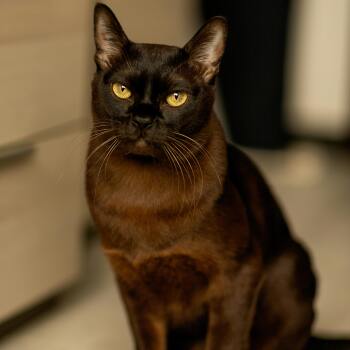Burmese

If you're lucky enough to share your life with a Burmese cat, you already know you've got something special. Are they the type who meows back when you talk to them? Or maybe they still play with the zest of a kitten? Ah, the joys of having a Burmese!
Why Burmese Cats Win Our Hearts
Burmese cats are no wallflowers; they’re the life of the party—and maybe even the ones planning it. Their curiosity knows no bounds, and they’ll eagerly snoop around any new situation. Got a puzzle? They’ll solve it. Heard a noise? They’ll investigate. Planning to take over the world? Count them in. Burmese cats are affectionate, intelligent, and social. They tend to be fabulous with kids and other pets, welcome strangers like old friends, and even groom themselves like little pros.
Endearing Quirks
Your Burmese may have an insatiable desire to be the center of your universe. Seriously—you might find them pawing at your book, photobombing your Zoom calls, or curling up on your keyboard. These social butterflies can grow anxious when left alone for long periods, so they thrive best in homes with lots of companionship.
History Snapshot
Our beloved Burmese cats trace their roots back to a single walnut-brown kitty named Wong Mau, brought to San Francisco from Burma in the 1930s. When paired with Siamese cats, Wong Mau became the matriarch of what we now know as the Burmese breed.
Built Like a Brick (Wrapped in Velvet)
You might pick one up and think, “Whoa, you’re heavier than you look!” You’re not wrong. Burmese cats are famously muscular, earning them the nickname "bricks wrapped in silk." Their coats are short, glossy, and luxurious—perfect for cuddles.
Genetic Predispositions for Burmese Cats
- Endocardial Fibroelastosis– This rare but serious genetic condition thickens the inner lining of the heart, which can lead to congestive heart failure in kittens. It’s incurable but detectable with early vet intervention. Breeding cats related to affected kittens should be avoided.
- Cardiomyopathy (HCM & DCM)– Heart muscle disease can creep in quietly, especially since cats often mask their symptoms. Biannual checkups help catch early signs like heart murmurs or rapid breathing. Diets with added taurine have helped reduce DCM cases.
- Arterial Thromboembolism (FATE)– This sudden blood clot condition often affects cats with existing heart disease. It typically causes severe pain and hind limb paralysis—always an emergency! Preventive medication may help lower risks in high-risk cats.
- Eye Issues (Glaucoma, Agenesis, Sequestration)– Burmese cats can experience several painful eye conditions, such as glaucoma (increased pressure), eyelid agenesis (incomplete lid formation), and corneal sequestration (dark patches on the eye). Routine eye exams help catch these early—some require surgery, but early detection makes all the difference.
- Diabetes Mellitus– Obesity, sedentary lifestyle, and certain genetic traits can increase diabetes risk. If your Burmese has increased thirst, weight loss, or frequent urination, talk to your vet. Many diabetic cats respond well to a high-protein, low-carb diet and lifestyle changes.
- Chronic Kidney Disease (Renal Failure)– Whether due to genetics or environmental factors, Burmese cats can be prone to renal disease. Special diets, hydration, and early bloodwork screening are key to long-term kidney health.
- FLUTD (Urinary Tract Issues)– If your cat starts peeing outside the box, don’t jump to conclusions—it could be a sign of Feline Lower Urinary Tract Disease. Males are especially at risk of dangerous blockages. Act quickly if you notice straining or blood in urine.
- Patellar Luxation– That little hop you see could be a slipping kneecap. Mild cases are manageable with arthritis meds, but surgery might be needed for more severe ones. We recommend screening at the time of spay or neuter.
- Hyperesthesia Syndrome– If your cat’s skin ripples when touched or they act overly sensitive, it may be due to feline hyperesthesia. It can mimic other conditions, so a full veterinary exam is essential. Medication may help ease their discomfort.
- Psychogenic Alopecia (Stress-Related Overgrooming)– Stress can trigger obsessive licking, leading to bald patches. Your vet will rule out allergies or parasites first. Environmental enrichment and behavior strategies usually help.
- Demodicosis (Mite Overload)– Microscopic Demodex mites live in all cats, but in Burmese, an overgrowth can lead to skin irritation and lesions. Diagnosis is simple, and treatment typically involves medicated baths or topical treatments.
Ready to Learn More? We’re Here to Help!


